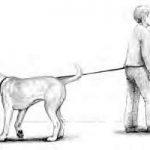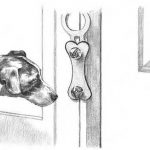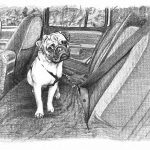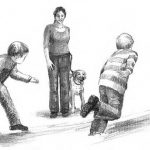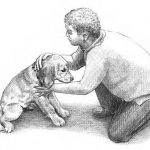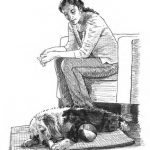In This Chapter
- Knowing when your dog becomes a senior
- Caring for your senior dog
- Recognizing age-related health issues
- Knowing when to say goodbye
Getting old is never easy, but you can make the transition a smoother one for your mixed-breed dog. In this chapter, I help you identify when your dog is really a senior, fill you in on his special health needs, and give him the kind of care he deserves. I also cover the most difficult decision of all: knowing when to let your best friend go.
Remember
Owning a dog is full of fun and excitement, and though the aging process can be sad, if you approach it with the right attitude, it can be a time for you to connect with your dog on an even deeper level than you already have.
How Old Is Old: Knowing When Your Dog Has Earned Senior Status
How will you know when your dog becomes a senior? He’s not going to suddenly need a cane to walk with. And you won’t need to puree his food one day when he was chewing on bones the day before. In fact, you may not see any outward signs at all. He may appear the same as he always has, at least for a while.
But over time, you’ll see a huge difference in your dog’s behavior, movement, physical appearance, and overall health. Age deteriorates the bones and muscle tissue; reduces the efficacy of internal organs; and dulls the senses. If your dog had any serious injuries when he was younger, the scar tissue surrounding those injuries will become inflamed. If he has a degenerative disease, such as hip dysplasia or spondylosis, it will take a firmer hold.
Tip
Here are some general guidelines on the aging process in dogs based on their size:
– Small dogs (up to 20 pounds): Many small dogs live upwards of 15 years, some as long as 18 to 20 years (though these often have some Poodle heritage — Poodles generally have a long lifespan). Small dogs can be considered seniors by the age of 11. In human years that’s about 60 years old; for each year beyond this, they age by 4 human years. So by the age of 12 they’re 64, by the age of 13 they’re 68, and so on.
Though your small dog may be a senior by 11 years, he may not really show this until a little later. Small dogs aren’t as prone to joint problems as bigger dogs are, but they do experience organ malfunction more prominently than their large cousins. Doing baseline testing (see Chapter Finding and Working with a Vet) will be extremely important to ensure you catch any health problems early.
– Medium dogs (21 to 50 pounds): Medium dogs tend to live anywhere from 13 to 15 years. They become seniors by the age of 9. In human years, this is equal to approximately 58 years old. If your medium-sized mixed breed lives to the age of 16, he’s equal in human years to an 83-year-old person, so you can be sure he’ll have slowed down and gotten cranky about his aches and pains.
– Large dogs (51 to 90 pounds): Large dogs tend to live about 10 to 12 years. They reach senior status by 8 years of age. At this time, they’re equal to a human who is 61 years old. The arthritis sets in, it’s tougher to move around, and the eyes and hearing get weak. Between the pain of achy bones and lack of seeing or hearing, they don’t respond as quickly as before. Your dog isn’t coming when called because of being stubborn — he didn’t hear you. By the time a large dog is 11 years old, if he reaches this age, he’s having extreme difficulty moving and responding to you. This old dog prefers to sleep and eat, and that’s about it.
– Extra-large dogs (over 90 pounds): Extra-large dogs generally live about 9 to 10 years. Extra large dogs are considered seniors by the age of 8. Dogs of this size age 7 to 10 years for each of our human years.
The Early-Bird Special: Feeding Your Senior Dog
As your mixed breed ages, his body changes. You shouldn’t feed him the same food in the same manner as when he was a pup. His metabolism has slowed down with his reduced exercise, and he won’t need as much food, or the same type of food (with both high calorie and fat content) as he used to.
Most dog-food brands offer a senior formula. When you’re deciding which one to buy, look for the following ingredients on the label:
– Vitamins C and E: As your senior dog’s immune system becomes less efficient with age, he’ll need a diet that contains a large amount of antioxidants such as vitamins C and E. This will help his immune system operate more efficiently, thereby reducing his risk of digestive-system problems and the drying of his skin and coat.
– Gamma-linolenic acid (GLA): Older dogs also need a diet that contains gamma-linolenic acid (GLA), which is an omega-6 fatty acid. This acid is normally produced in your mixed breed’s liver by the enzyme action on dietary fat. However, in older dogs, these GLA levels are diminished. If your dog’s favorite senior food doesn’t have GLA in it, you can add borage oil, a natural source of this acid, to your dog’s diet. You can find borage oil at most vitamin outlets. One tablet is usually sufficient.
– Fructoligosaccharides (FOS): Older dogs have more frequent intestinal problems than younger dogs do, so your dog will need to have a diet containing fructoligosaccharides (FOS). This is a unique fiber source that aids in maintaining a healthy bacterial population in his intestines. Beet pulp is a good source of FOS and provides energy for the cells that line his intestine, which helps with proper stool formation. It’s often already added to most commercial senior dog diets.
Remember
Don’t feed your senior dog a food with more than three grains — they’re tough to digest (see Chapter Chasing the Chuckwagon: The Basics of Feeding).
You probably won’t need to change your mixed breed’s feeding schedule or how he eats, though it’s always a good idea to elevate his food bowl at least a little to help the food go down smoother. This is especially helpful for senior dogs who have trachea problems, such as a collapsed trachea, making swallowing difficult. (You can find special elevated feeders at any major pet store or online pet store.)
As your dog becomes older, make sure you feed him in a quiet environment where other family pets won’t disturb him. Many older dogs eat slowly and will feel challenged by the other animals.
Your dog will let you know if you’re feeding him too often: He simply won’t eat the meal. Don’t fall into the “always hungry” trap though, or your senior dog will quickly become overweight, which in turn will stress his heart and skeletal system, shortening his life.
Use It or Lose It: Exercising Your Senior Dog
Senior dogs need exercise. Keeping him in shape will help him deal with his physical and emotional changes. Exercise maintains muscle tone, in turn supporting his weakening joints. It also helps his digestive system and circulatory system.
Don’t keep your dog locked up just because he’s limping from arthritic joints. This will quickly increase the deterioration. Exercise promotes healthy bone growth and keeps your mixed breed happy. A dog who isn’t exercised quickly declines.
Social time with other dogs
Your old mixed breed may not be able to keep up with the younger pups, but he’ll have fun trying. And it’s not just a matter of having fun. It’s a type of exercise you can’t offer — unless you’re willing to lie down on the ground, gnaw on his ear, roll, jump, and chase him. (I didn’t think so!) But these are all things dogs do when they play.
If your older dog has health issues, such as arthritis or breathing problems, be cautious with his choice of playmates. Let him play with a dog who isn’t super-energetic or dominant.
Not only is playing with other dogs good for your old friend, it’s also good for the younger dogs, because your old dog teaches them important social skills. Your old dog has been around the block a few more times than they have, and he has all kinds of wisdom to pass on to those youngsters.
Walks with you
Your old dog may have a great time playing with other dogs, but he’d really prefer to spend time with you. Both of you will benefit from walks together. It’s a healthy, low-impact means of exercise, and you can hardly have more enjoyable company.
If your older dog can’t rough-house and race around with other dogs, walking will be his only way of moving around and keeping his muscles toned. You can regulate his exercise regimen — his speed, distance, and terrain.
Tip
If your mixed-breed dog is arthritic or suffering from an old injury, walk him on a soft surface (like dirt), not a hard road or sidewalk. This will cushion each foot fall, making each step less jarring.
Identifying Health Problems Common to Seniors
There’s no helping it. All our bodies wear down as we age, and your dog is no different. You can slow down the degeneration with proper diet and exercise, but ultimately it’s unavoidable. That said, deterioration is different in each dog. Larger dogs tend to develop arthritic joints before losing their eyesight or hearing, whereas smaller dogs are just the opposite.
In the following sections, I walk you through the most common age-related problems that dogs face.
Hearing loss
It doesn’t matter which breed mixture your dog is when it comes to hearing loss — deafness is seen in all breeds.
Technical Stuff
Hearing loss happens either because of damage to the inner-ear components from an ear infection, from trauma to the head and nerves, or through the use of various drugs such as the antibiotics Gentamicin, Neomycin, and Kanamycin. Over time, the ear components can also degenerate, causing a gradual deafness.
Your vet can perform tests to discover the extent of your dog’s hearing loss, but there are ways you can detect the loss of hearing in your mixed breed on your own. A couple of the main symptoms are difficulty arousing from sleep and awakening with aggression. His verbalizations will be higher pitched. And he’ll also have difficulty figuring out where sound is coming from.
Tip
Most dogs adjust to this loss of hearing quite well, and there are ways you can also adjust to it, too. You can begin by using more visual cues or lights to get your dogs’ attention — laser lights are great for this.
Blindness
All dogs have decreased vision as they age (and you probably do, too!) — it can’t be avoided.
Technical Stuff
Loss of sight is normally due to changes in pupil size and the loss of focusing correctly. Due to the aging process other disorders and diseases occur because of the downward shift of eyelid tissues and atrophy of the orbital fat.
Tip
Your dog’s vision may be reduced as he ages, but he’ll easily adjust to this, and it most likely won’t affect his overall quality of life. You can help by not changing the furniture around, and not leaving objects on the floors that he can’t easily detect.
Arthritis
There’s no avoiding arthritis. (Are you sensing a pattern here?) If it doesn’t occur from an old injury, it most certainly sets in with age.
Technical Stuff
Arthritis is a disease in which the cartilage in the joints deteriorates. Without the cartilage, the bones of the joints rub together, causing painful movement.
The symptoms of arthritis are obvious: difficulty walking; limping; a stiff, slow, ungainly gait. Sometimes you can hear a dog’s joints creaking and crackling. You may even hear your dog’s nails scraping against the floor as he walks.
Tip
There are many ways you can help your arthritic dog. Exercise helps maintain mobility and flexibility. You don’t want to push your dog too much, but one or two very short walks a day (maybe around the block) will keep him moving. (You’re better off breaking his walks into multiple sessions instead of taking one long walk.) Another way to ease the pain of arthritis is to make sure you don’t let your dog become overweight. The heavier he is, the more stress is put on his joints. Also, numerous supplements are available that contain glucosamine and chondroitin — these nutrients lubricate the joints causing less friction between the bones. You can find them in chewable tables that your dog will eat up like treats.
Digestive disorders
Many old dogs get some sort of inflammatory disease of the gastrointestinal tract — a chronic irritation in his bowels, stomach, and/or intestines. When your dog has this disease, he’ll vomit and/or have diarrhea. Left untreated, he’ll lose weight and not be able to eat normally.
The symptoms can be caused by food allergies or stress. Sometimes emotional trauma can bring on the symptoms of intestinal disorders.
A diet change is often the first step. Your vet may suggest corticosteroids and other drugs if diet control isn’t enough. Talk to your vet to see what she recommends.
Cancer
Cancer is a very common ailment in dogs — and it’s often fatal. Because older dogs tend to be weakened with age, knowing whether to put your dog through the difficult and expensive treatments necessary to control the disease is tough.
Cancer of the organs is normally fatal. Skin cancer, however, can often be treated with removal of the tumor and chemotherapy or radiation applied to the affected area to kill any remaining cancerous cells. Dogs tend to become ill when given the first chemotherapy treatment, but they tend to tolerate subsequent treatments fairly well.
You may want to investigate some alternative therapies. Nutritional and herbal components are currently being tested in dogs, and some are looking very promising. Talk with your vet about all your options, and don’t hesitate to seek a second opinion if you feel it’s necessary.
Dementia
If your dog has Cognitive Dysfunction Syndrome (CDS, or dementia), he might exhibit the following behaviors:
– Disorientation: Your dog might be confused, wander aimlessly, go to the wrong side of doors, or get stuck in corners or behind furniture.
– Change in sleep patterns: Your dog will sleep more during the day and less at night. He may tend to wander aimlessly throughout the night.
– Housetraining regression: Your dog may go outside, forget why, and then comes inside only to relieve himself on your floor.
– Avoiding family interaction: He may walk away from you instead of wanting attention. He won’t want to play as he used to.
Other symptoms include obsessive/compulsive disorders, separation anxiety, fear biting, environmental phobias (such as fear of thunder or other loud noises), and overall aggression. The aggression can be a variety of types, from fear biting to your dog being more territorial or possessive.
A medication called L-Selegeline can be prescribed by your vet that will help with the early symptoms of CDS. Most dogs show some improvement within the first couple weeks, but there are some, such as those in whom the CDS is quite advanced, who won’t show any improvement at all. The medication has few side effects, but some dogs have mild gastrointestinal upset when they’re on the drug. Those dogs who improve with Anipryl must remain on it the rest of their lives, or until the CDS progresses to the point where the drug is no longer effective.
If you think your dog may have CDS, talk to your vet. She’ll be able to diagnose the condition and tell you about your treatment options.
Depression
Dogs are emotional and form lifelong attachments. So when they lose someone they dearly loved — whether a human companion or another animal — they can develop depression, just as humans can. Depression can also be brought on because of a change of scenery (maybe you moved to a new home) or because of weather changes or health changes.
Regardless of the cause, the symptoms include
- Excessive barking
- Lethargy
- Anxiety or nervousness
- Obsessive behavior such as excessive grooming, self-mutilation, or destructiveness
- Weight loss or gain
- Sulking
- Aggression
- Increased clinginess
When you recognize these behaviors as depression, there are steps you can take to help your dog. Your vet can prescribe antidepressant medication. You can also improve the quality of your dog’s life by increasing his activities and social life. Keep him busy!
Warning!
Left too long, depression can turn into a life-threatening physical condition.
Recognizing Behavior Problems That Sometimes Come with Age
Along with the physical changes that come with age, your mixed breed will also experience behavior and emotional changes. In fact, you’re likely to see the behavior changes before the physical ones, because most dogs won’t exhibit signs of physical weakness or injury — doing so decreases their standing within a dog pack.
Physical problems can actually cause behavioral problems. The onset of arthritis, for example, creates chronic pain, which in turn makes your dog increasingly grouchy. If cancer is growing, your dog may appear distracted, may not listen well, or may have the tendency to strike out aggressively without reason.
Overall, your older dog will be less likely to respond to obedience commands. If he’s in pain, it hurts to move. If he can’t hear you call him to come, he won’t. If he doesn’t see your visual cues to sit, he can’t. If he doesn’t remember what your cues mean, he doesn’t know how to respond to them.
Dogs who once allowed young children to crawl all over them may suddenly lash out or go hide when they get older. Some dogs who once loved playing with other dogs no longer want to do so. Then there’s the personal space issue — as dogs age, this becomes more prominent. Their personal-space needs increase, because they don’t want to be stepped on or jostled by a person or another dog.
There are reasons behind all this impatience and aggression. The most common is pain from arthritis. Another reason is that your old dog doesn’t see or hear well enough to be forewarned of another presence. And, sadly, as dogs age, some develop dementia; the neurons in their brain aren’t firing as efficiently as they once did. All these can cause your dog to be impatient.
Pain causes bad moods. If someone were to touch a very painful place on your body, you might yell at him. A dog may bark, snap, or even outright attack. All your dog knows is that someone who touched him caused the more intense pain.
If your dog is experiencing dementia, and doesn’t understand his world anymore, he’ll tend to be more touchy and aggressive. He won’t remember his people or other animal pack members — they’ll be strangers to him. If they get in his personal space, watch out!
Remember
If your dog is in pain or is suffering from Cognitive Dysfunction Syndrome (CDS, or dementia — see the “Dementia” section, earlier in this chapter), keep other animals and small children away from him.
Tip
Your vet can tell if your dog is suffering from dementia, and he’ll also be able to gauge how much pain your dog is in from arthritis or other health problems.
If your dog can’t hear or see something coming, how can he prepared when it comes? Dogs rely heavily on their senses to understand their world. If they can’t sense someone coming from behind them, or are awakened suddenly, their first instinct is to lash out. This can be especially dangerous in a home with youngsters, because they don’t understand why their dog has suddenly become less loving.
Tip
If your dog is losing his eyesight or hearing, you’ll need to change how others interact with him. There are ways you and your kids can inform your dog of your approach. For example, if your dog is losing his hearing, clap your hands or stomp loudly on the floor before you get close to him. Your dog still feels vibrations fairly well, and this will alert him. If he can’t see well, try flashing the lights on and off to grab his attention.
Saying Goodbye
As dogs age, they become debilitated by illness. You love your dog and you hate to watch him suffer. Though most dogs try to hide pain, you need to know what to look for beyond the obvious. Here are some behaviors that might give you an indication of your dog’s level of discomfort:
- Limping
- Obsessive scratching
- Licking an area
- Unusual mouth movements or excessive panting
- Frequently turning his head to look at his painful area
- Roaming in circles, pacing, or erratic movements
- Reluctance to get up or lie down, climb stairs, or get into the car
- Trembling or tension
- Being quieter or more clingy than usual
- Retreating or withdrawing from his family and animal companions
- Lack of appetite
If you’ve done all you can to try to alleviate his pain but he still displays the symptoms of extreme discomfort, you need to figure out whether now is the time to let your dog go. How do you make that decision? Ask yourself some important questions.
– Why is he still here? For your benefit? Will you be lonely without him? If that’s the only reason you’re keeping your dog alive, you’re putting your own needs ahead of your dog’s.
– What is his quality of life? Is the expensive veterinary treatment you’re putting him through merely adding days or weeks to his life? Or is it adding years — and if so, what kind of years? Happy, pain-free ones, or ones of misery? If you’re only adding a couple days or weeks, think about the quality of life he’s leading. Is he comfortable? Is he happy? Is he wanting to go outside and play, or hiding in a corner?
Overall, you need to consider whether your dog’s bad days outweigh his good ones. Try to be objective in your assessment and be fair to your dog.
Although your vet can tell you there’s not much more you can do to help your dog, only you can make the final decision. Your mixed breed has been your loving companion for many years. You’ve cared for him, shared wonderful moments together, and enjoyed each others’ company. You don’t want him to suffer — you’ll be suffering alongside him, and he won’t understand your sadness and grief, which will only make him even more depressed.
I’ve had to make this impossible decision more times than I can count. It never hurts less, and I’ll never forget the dogs I’ve helped travel to the Rainbow Bridge. I still see them in my mind; in the rearview mirror of my vehicle, smiling at me as they look forward to adventure; the times we shared hiking, camping, and working. Every one of them is still special to me and will forever live within my soul.
Remember
You know and love your dog — and you’ll know when the time is right to say goodbye.
Whether you’re thinking about putting your dog to sleep, or you’ve recently done it, talking with friends and family helps. They can be a huge support, helping you weigh your options and cope with your grief. Your family and friends understand the loss of your dog better than anyone else. They’ve seen the relationship you shared. They’ll understand your stories and sit there holding you as you cry.
Tip
In addition to your friends and family, there are books you can turn to, Web sites to go to. Here are just a few:
– Pet Loss and Children: Establishing a Healthy Foundation, by Cheri Barton: If you have children, this book will guide you in helping them, and yourself, through the loss of your beloved dog. I like how it involves the children in the recovery process through artistic expression and teaches how to recognize when to say goodbye.
– Saying Good-Bye to the Pet You Love: A Complete Resource to Help You Heal, by Lorri A. Greene and Jacquelyn Landis: This book helps you overcome grief by writing out your memories. It also mentions how taking a moment to remember your pet through a special memorial is helpful. This book also helps you recognize when the time is right to say goodbye.
– Pet Loss: How to Prepare, Say Goodbye, Honor Your Pet’s Life, by Lisa Shover: This book covers everything you need to recognize when it’s time to say goodbye, how to go about the process, how to help others as they grieve and how to create a memorial for your dog.
– PetLoss.com (www.petloss.com): This is a great Web site for counseling, support, and information regarding pet loss. This group also has a regular Monday-night candle vigil paying tribute and memorializing our lost loved ones.
– The Association for Pet Loss and Bereavement (www.aplb.org): This Web site is a great resource for anyone who needs help in preparing for the loss of a pet or who needs support in the grieving process. There are chat rooms and actual counselors available to speak to. Sometimes all you need is an ear to listen to your stories.
If you’re really having trouble coping with the loss of your pet, seek the help of a professional grief counselor. You can talk to your family physician to get a referral of someone in your area.
Remember
Don’t feel guilty about your decision to put your dog to sleep. You kept him from pain and suffering, and that’s the most responsible thing a pet owner can do.
by Miriam Fields-Babineau











